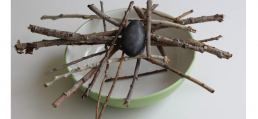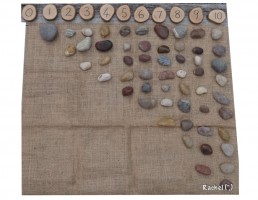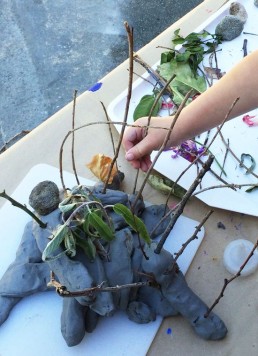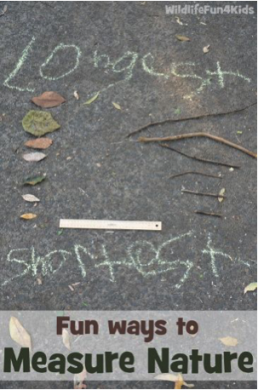Stick and Stone Balancing Activity
Resources – Sticks, a stone and a bowl
Implementation
Use your problem solving and fine motor skills to lay your sticks out and balance the stone so it doesn’t fall through into the bowl. As a challenge limit the amount of sticks and use a smaller stone!
Intent – Learning goals
Characteristics of Effective Learning
Playing and Exploring –
Being willing to ‘have a go’
- Initiating activities
- Seeking challenge
- Showing a ‘can do’ attitude
- Taking a risk, engaging in new experiences, and learning by trial and error
Active Learning –
Being involved and concentrating
- Maintaining focus on their activity for a period of time
- Showing high levels of energy, fascination
- Not easily distracted
- Paying attention to details
Keeping on trying
- Persisting with activity when challenges occur
- Showing a belief that more effort or a different approach will pay off
- Bouncing back after difficulties
Enjoying achieving what they set out to do
- Showing satisfaction in meeting their own goals
- Being proud of how they accomplished something – not just the end result
- Enjoying meeting challenges for their own sake rather than external rewards or praise
Creating and Thinking Critically
Having their own ideas
- Thinking of ideas
- Finding ways to solve problems
- Finding new ways to do things
Making links
- Making predictions
- Testing their ideas
Choosing ways to do things
- Planning, making decisions about how to approach a task, solve a problem and reach a goal
- Checking how well their activities are going
- Changing strategy as needed
- Reviewing how well the approach worked
Matching Quantity to Numerals
Resources: Stones, pens, numbers
Collect up all those stones you find on your walks and match them to the numbers. You can write the numbers on a piece of paper or use any numbers you have. As an extension you could continue to 20.


Intent- Learning Goals
Maths - Numbers
30-50 months
Recites numbers in order to 10.
- Knows that numbers identify how many objects are in a set.
- Beginning to represent numbers using fingers, marks on paper
or pictures.
- Sometimes matches numeral and quantity correctly.
- Shows an interest in number problems.
- Shows an interest in representing numbers.
40-60
- Recognise some numerals of personal significance.
- Recognises numerals 1 to 5+
- Counts up to three or four objects by saying one number name for each item.
- Counts objects to 10, and beginning to count beyond 10.
- Counts out up to six objects from a larger group
Impact
How did this activity go? Please use this space to record any findings, adaptions, reflections and quotes from your children. We would love you to email them back to us or share them on Tapestry, Instagram or Facebook.
Activity 5- Stick Models
Resources: Sticks and home made play dough or messy but fun naturally sourced mud or clay.
Easy make at home play dough recipe: https://www.youtube.com/watch?v=jv73CEzY1jg
Implementation
To extend on your 2D stick shapes, have a go making 3D shapes or models using your sticks and playdough/mud to hold them together.
You may have your own ideas of what works best for you
that you can also share with us.
What would you like your model to look like?
What you will use?
How will you? What else might work? What could you do differently?
What could you add? What does it remind you of?
Can you tell me about your model?
Intent
Characteristics of Effective Learning – Creating and Thinking Critically
Having their own ideas
- Thinking of ideas
- Finding ways to solve problems
- Finding new ways to do things
 Making links
Making links
- Making links and noticing patterns in their experience
- Making predictions
- Testing their ideas
- Developing ideas of grouping, sequences, cause and effect
Choosing ways to do things
- Planning, making decisions about how to approach a task,solve a problem and reach a goal
- Checking how well their activities are going
- Changing strategy as needed
- Reviewing how well the approach worked
Maths – Shape Space and Measure
22-36 months
- Notices simple shapes and patterns in pictures.
30-50 months
- Shows an interest in shape and space by playing with shapes or making arrangements with objects.
- Uses positional language.
- Shows interest in shape by sustained construction activity or by talking about shapes or arrangements.
- Uses shapes appropriately for tasks.
40-60 months
- Beginning to use mathematical names for ‘solid’ 3D shapes and ‘flat’ 2D shapes, and mathematical terms to describe shapes.
- Uses familiar objects and common shapes to create and recreate patterns and build models.
Expressive Arts and Design – Exploring using Media and Materials
30-50 months
- Uses various construction materials.
- Beginning to construct, stacking blocks vertically and horizontally, making enclosures and creating spaces.
- Joins construction pieces together to build and balance.
40-60 months
- Understands that different media can be combined to create new effects.
- Manipulates materials to achieve a planned effect.
- Constructs with a purpose in mind, using a variety of resources.
- Selects appropriate resources and adapts work where necessary.
- Selects tools and techniques needed to shape, assemble and join materials they are using.
Impact
Please use this space to record any findings, adaptions, reflections and quotes from your children. We would love you to email them back to us or share them on Tapestry.
Home School Activity 2: Sticks
Resources: Sticks
Implementation
We see a lot of you found sticks during your scavenger hunt, so using these sticks, encourage your children to look at the sizes of them and ask what they can see.
 Support them if necessary to place the sticks into size order using mathematical language of size and length, long, short, biggest, smallest, medium etc.
Support them if necessary to place the sticks into size order using mathematical language of size and length, long, short, biggest, smallest, medium etc.
Extension – using a stone, hands, Lego or what your child believes would be appropriate, (trial and error and problem solving) you could measure the sticks and record your findings with any representation suitable with your child’s ability, such as drawing pictures, taking photographs, writing digits.
Intent- Learning Objectives-
Here's what your children will get out of this activity, within their age brackets.
Maths- Shape, Space and Measure
22-36 months
- Beginning to categorise objects according to properties such as shape or size.
- Begins to use the language of size
30-50months
- Uses positional language.
40-60 months
- Orders two or three items by length or height
PSED – Personal, Social, Emotional Development
30-50 months
- Can select and use activities and resources with help.
- Welcomes and values praise for what they have done.
- Enjoys responsibility of carrying out small tasks.
- Shows confidence in asking adults for help.
40-60 months
- Confident to speak to others about own needs, wants, interests and opinions.
- Can describe self in positive terms and talk about abilities.
Impact- Please use this space (or a sheet of paper) to record any findings, adaptions, reflections and quotes from your children. We would love you to email them back to us or share them on Tapestry.
Happy Measuring.
The VIN Team (Virtual Inspirations Nursery)




